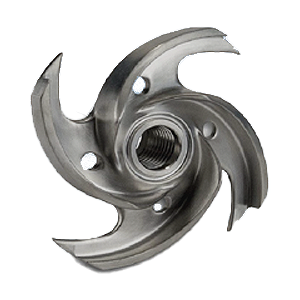Types of impellers
Impeller classification
According to the different blade forms, it is divided into three categories: open impeller, closed impeller, and semi-open impeller.
It can also be divided into multi-stage and single-stage according to the number of stages of the pump.
The closed impeller consists of front and rear cover plates and blades;

The semi-open impeller consists of blades and back cover;


Open impellers have only blades and part of the back cover or no back cover.

Both closed and semi-open impellers are widely used as accessories in centrifugal pumps. Although centrifugal pumps that use closed impellers are generally more efficient and energy efficient, these two different impeller designs have their own advantages and are suitable for different fluid situations. Below we will focus on the characteristics and advantages of semi-open impellers and closed impellers.
Semi-Open and Closed Impellers: Flow
Because the closed impeller has front shroud and back shroud, the axial thrust of the pump is lower than that of the semi-open impeller, and the gap between the impeller and the volute is smaller, so it is suitable for conveying clean water, solutions and other low-viscosity particles without particles cleaning liquid. When the motor drives the impeller to start to rotate, the liquid flows from the center of the impeller to the outer edge, and a low pressure area is generated in the center of the impeller. Therefore, the liquid will be sucked into the center of the impeller, and the liquid will be driven by the impeller and then move in the pump casing in a circle, so the pump efficiency is relatively high. The clearance of the semi-open impeller is larger than that of the closed impeller, which will lead to increased local turbulence and affect the pump efficiency. Therefore, semi-open impellers usually have a lower low rate.
Semi-Open vs Closed Impellers: Cost
Using more material (cast iron, alloys, bronze, etc.) in the casting or manufacturing process of closed impellers will generally cost more than semi-open impellers. Additionally, our castings for enclosed impellers tend to be more complex and therefore more expensive. Therefore, after-sales service and repair costs may be higher. When the clearance of the sealing ring is too large, it must be replaced. Worn seal rings result in higher operating costs and lower operating efficiency. The axial pressure of the pump is also different due to the different impeller geometries. Lower axial pressure equates to lower bearing loads and potentially lower maintenance costs, so these design differences should be carefully considered when selecting.
Semi-Open and Closed Impellers: Maintenance
Semi-open impellers tend to have higher axial pressure characteristics than closed impellers. This is because the forces on the closed impeller front shroud tend to counteract the forces on the rear shroud. In contrast, semi-open impellers do not have a front shroud and discharge pressure builds up behind the impeller. In order to solve this problem, the semi-open impeller may increase the structure of the balance hole (which will lead to a slight decrease in pump efficiency). After a long period of use in the field, the gap between the blades of the semi-open impeller and the casing will be reduced due to wear and tear. increase. This will result in a reduction in efficiency and head. In most semi-open pumps, the rotor itself can be adjusted to close this gap and pump performance will be restored. In contrast, axial adjustment of a closed impeller has little effect on changing pump performance.
Semi-Open and Closed Impellers: Applications
When to use a closed impeller versus a semi-open impeller will depend on the usage scenario. Enclosed impellers can better handle excessive shaft temperatures due to high fluid pumping temperatures, and increased pump efficiency. Generally the "first choice" for clean water, high temperature and energy saving applications etc. Semi-open impellers are better for liquids that carry solids because there is no fixed impeller center through which the liquid must pass, and impellers with two shrouds have no size restrictions. The wear of the semi-open impeller can be solved by the axial adjustment of the rotor. In addition to pump efficiency (such as electrical and total operating costs) that should always be considered in impeller selection, there are many variables to consider.
